I had thought, naively, that the patio would be done yesterday. Denise and I worked really hard on it, and Kevin came and did a lot, and helped me learn to use a tamper. I think I'm going to stick with my non-tamping day job.
Sunday, June 28, 2009
New patio visitor
Sources tell me that this is a Gulf Frittilary, Agraulis vanillae. She/he? came to visit yesterday, and landed on the base rock for the new patio. I've noticed more species of butterflies around this year. We always have painted ladies and swallowtails, but I've never noticed one of these before.



I had thought, naively, that the patio would be done yesterday. Denise and I worked really hard on it, and Kevin came and did a lot, and helped me learn to use a tamper. I think I'm going to stick with my non-tamping day job.
 And Eric showed me yesterday that he thinks the patio should be bigger, and I had to agree with him. So I get to spend the rest of this week digging and leveling, then putting down more base rock. At least I'll get to use a tamper again!
And Eric showed me yesterday that he thinks the patio should be bigger, and I had to agree with him. So I get to spend the rest of this week digging and leveling, then putting down more base rock. At least I'll get to use a tamper again!
I had thought, naively, that the patio would be done yesterday. Denise and I worked really hard on it, and Kevin came and did a lot, and helped me learn to use a tamper. I think I'm going to stick with my non-tamping day job.
Friday, June 26, 2009
Wednesday, June 24, 2009
Almost 4 year old view
All I can say is, thank goodness for digital photography. I can carefully set Caterina up with the camera, and she takes pictures of her favorite things.
First, "her" garden. We set the small beds up for the four children, but only two are showing any real interest. Cat keeps asking for more things to be planted in her bed, but I've told her she's going to have to have a bigger one soon. This baby is crowded. Almost-empty rain tote and displaced deck chair behind.
 The garden has to feel a little bit like a jungle to someone shorter than it is. See how it looms over her?
The garden has to feel a little bit like a jungle to someone shorter than it is. See how it looms over her?

My experience says there's always at least a little chaos in a garden (or maybe it's just my family) but the deck project has more things tossed around. This is from between our house and the neighbor's house. I'm looking forward to having stairs again to hang the laundry. Schlepping it down the basement stairs which are nowhere near code just isn't going to happen.

Lastly, the near-overgrown area between the houses. I think I have long-term plans for it, but right now it's fun to sort of hack my way through like a jungle explorer.

Then I think I distracted her and wrestled the camera away. My pictures on another day.
First, "her" garden. We set the small beds up for the four children, but only two are showing any real interest. Cat keeps asking for more things to be planted in her bed, but I've told her she's going to have to have a bigger one soon. This baby is crowded. Almost-empty rain tote and displaced deck chair behind.
My experience says there's always at least a little chaos in a garden (or maybe it's just my family) but the deck project has more things tossed around. This is from between our house and the neighbor's house. I'm looking forward to having stairs again to hang the laundry. Schlepping it down the basement stairs which are nowhere near code just isn't going to happen.
Lastly, the near-overgrown area between the houses. I think I have long-term plans for it, but right now it's fun to sort of hack my way through like a jungle explorer.
Then I think I distracted her and wrestled the camera away. My pictures on another day.
Monday, June 22, 2009
When seasons collide
The next-to-last carrot along with some early plums. The carrot was tasty, crunchy, just what a carrot should be, and the plums?
I don't know because Caterina ate them both. Hmph. Maybe as the trees get bigger, I'll get more. In five minutes today I picked about two or three pounds of plums from the tree at our church. Half to the food bank, half to the local fruit exchange, and a few got eaten by. . Caterina. Of course.

I don't know because Caterina ate them both. Hmph. Maybe as the trees get bigger, I'll get more. In five minutes today I picked about two or three pounds of plums from the tree at our church. Half to the food bank, half to the local fruit exchange, and a few got eaten by. . Caterina. Of course.
Sunday, June 21, 2009
All hands on deck
The guys say, "Taking it apart is the easy part," and they may be right. All I know is that I came home from church today, and saw this:

That was the original deck footprint -- all the way to the edge there, albeit with more boards. Staircase on the right. This is looking the other direction, from the top of the staircase. Notice how you can see all the neighbors' yards from the deck? Nice if you're into that, I suppose. Not the view I want with my morning tea.

Later, the deck has been reduced to its future depth -- just as deep as the landing needs to be. The staircase is doomed also.


My jobs were pulling nails and stacking lumber neatly. This week, I get to grade the new patio area and order gravel. If I work really fast, I'm going to start building new beds. I suppose weeding will have to fill in there somewhere; I've foolishly let waaaay too many foxtails go to seed. A shop vac, perhaps?
This is the "new" and diminished deck. The stairs will be moved to the left here, so you'll have to turn out the door to go down. That way, when we're on the patio, the staircase won't bisect the view of the garden, but sort of frame the sitting area. That pile of "old deck" is going to be "new gardens" at some point!
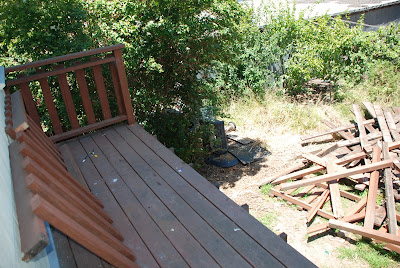
Eric said that he's spent many a Father's Day like this -- pulling nails, using saws, just generally working. We both have the sunburns to show for it. I'm excited at how quickly it seems to be going and how much fun it looks as though the new layout will be. The kids just want to rappel off of the edge of the deck. (Don't worry; there's caution tape up now and besides, we have the sort of children who could rappel or jump without danger.)

That was the original deck footprint -- all the way to the edge there, albeit with more boards. Staircase on the right. This is looking the other direction, from the top of the staircase. Notice how you can see all the neighbors' yards from the deck? Nice if you're into that, I suppose. Not the view I want with my morning tea.

Later, the deck has been reduced to its future depth -- just as deep as the landing needs to be. The staircase is doomed also.


My jobs were pulling nails and stacking lumber neatly. This week, I get to grade the new patio area and order gravel. If I work really fast, I'm going to start building new beds. I suppose weeding will have to fill in there somewhere; I've foolishly let waaaay too many foxtails go to seed. A shop vac, perhaps?
This is the "new" and diminished deck. The stairs will be moved to the left here, so you'll have to turn out the door to go down. That way, when we're on the patio, the staircase won't bisect the view of the garden, but sort of frame the sitting area. That pile of "old deck" is going to be "new gardens" at some point!

Eric said that he's spent many a Father's Day like this -- pulling nails, using saws, just generally working. We both have the sunburns to show for it. I'm excited at how quickly it seems to be going and how much fun it looks as though the new layout will be. The kids just want to rappel off of the edge of the deck. (Don't worry; there's caution tape up now and besides, we have the sort of children who could rappel or jump without danger.)
Saturday, June 20, 2009
Inspiration
As my gardening urges have increased, so has my garden greed. I don't want "a" garden, I want a bigger garden! I want it all garden, bwaa haa haa. (I'm just east of cackling, not something you want to do if you're already starting to look like the Sicilian crone you hope devoutly one day to be.)
But I also don't want an unattractive layout, hardscape-wise. Since my tastes run to the extremely rectilinear, I worried that any garden plan I'd do would look like a garden at a prison or military installation. Fancy, curvy, and "designed" seemed like such a better idea. But it's also less "me" than straight.
Friday, the eldest and youngest child and I had a day out together. We managed to sweet-talk our way into a closed city garden with promises of weeding. I did weed (perversely happy to see Bermuda grass invading their heavily-tended garden plots too) and spent a pleased half hour wandering around and looking at vegetables and herbs.
Then it happened. I stumbled across a design that seemed like it would work in my yard, with my aesthetic, and perhaps most importantly, with reclaimed materials from our deck.
I can hardly wait to try this at home:


Click to make bigger -- and can't you just see a string of lights along the peak? I'm having almost as much fun imagining this as I assume I will have making it.
But I also don't want an unattractive layout, hardscape-wise. Since my tastes run to the extremely rectilinear, I worried that any garden plan I'd do would look like a garden at a prison or military installation. Fancy, curvy, and "designed" seemed like such a better idea. But it's also less "me" than straight.
Friday, the eldest and youngest child and I had a day out together. We managed to sweet-talk our way into a closed city garden with promises of weeding. I did weed (perversely happy to see Bermuda grass invading their heavily-tended garden plots too) and spent a pleased half hour wandering around and looking at vegetables and herbs.
Then it happened. I stumbled across a design that seemed like it would work in my yard, with my aesthetic, and perhaps most importantly, with reclaimed materials from our deck.
I can hardly wait to try this at home:
Click to make bigger -- and can't you just see a string of lights along the peak? I'm having almost as much fun imagining this as I assume I will have making it.
Wednesday, June 17, 2009
Insipid Aqua
Knitting and fiber arts are another passion of mine, and when I can combine them with gardening, I'm a happy woman. This year, the Japanese Indigo made a nice showing in the garden.

With a little research, I found a way to use them to dye fiber. Cut them above these nodes, and they'll resprout like basil.
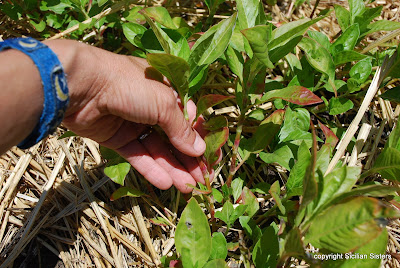
4 ounces of indigo, ready for the dyepot. Unlike indigo powder, this has to be used asap.
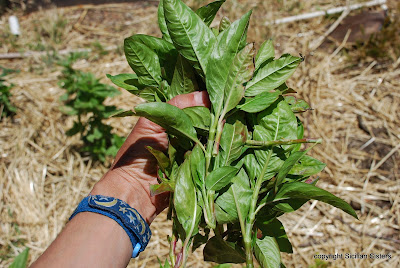
Stuffed into a half gallon of water, I bring the mixture to 160 F.

It's an uninspiring brown at this point.
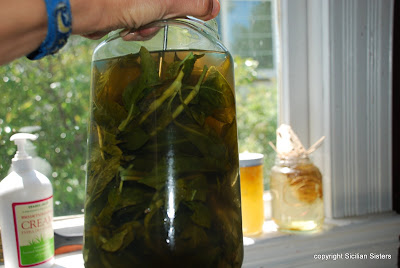
After straining out the leaves, adding non-sudsing ammonia to alter the pH level, I pour the liquid back and forth to aerate the mixture. It changes color!
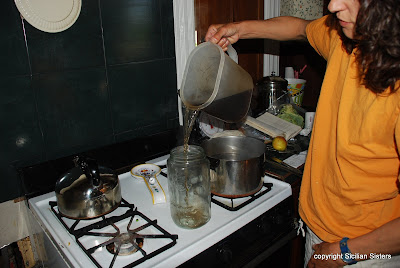
Now you can see the yarn stuffed in there. Before I did that, I added some Rit dye remover. That deoxygenates the mixture, and it turns a classic indigo dyebath color -- clear green.
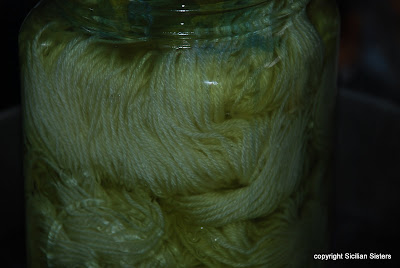
If the jar hadn't broken, dumping the dyebath into the double boiler, it might have turned a bluer color. But the real magic of dyeing with indigo is that as you raise the fiber out of the dyepot, it's green (or in this case, only greenish). As the fiber interacts with the air, the color changes to blue! You can see in this picture that it's moving down the skein as the water is draining out.
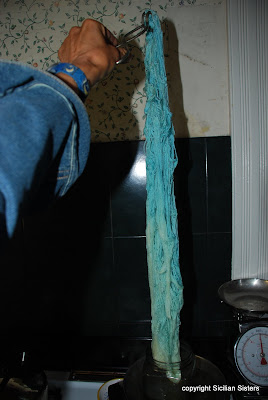
Unfortunately for me, it did end up sort of an insipid aqua color. Not my (or Denise's) real favorite, a bummer since it was intended as a surprise birthday present for her. Fortunately we know a knitter who will actually like the color. I'm going to give it to her tomorrow. It's never a total waste!
I'm hoping to try the experiment again with fiber, not yarn, and an unbroken dye jar. To that end, I'm watering the indigo carefully.
With a little research, I found a way to use them to dye fiber. Cut them above these nodes, and they'll resprout like basil.
4 ounces of indigo, ready for the dyepot. Unlike indigo powder, this has to be used asap.
Stuffed into a half gallon of water, I bring the mixture to 160 F.
It's an uninspiring brown at this point.
After straining out the leaves, adding non-sudsing ammonia to alter the pH level, I pour the liquid back and forth to aerate the mixture. It changes color!
Now you can see the yarn stuffed in there. Before I did that, I added some Rit dye remover. That deoxygenates the mixture, and it turns a classic indigo dyebath color -- clear green.
If the jar hadn't broken, dumping the dyebath into the double boiler, it might have turned a bluer color. But the real magic of dyeing with indigo is that as you raise the fiber out of the dyepot, it's green (or in this case, only greenish). As the fiber interacts with the air, the color changes to blue! You can see in this picture that it's moving down the skein as the water is draining out.
Unfortunately for me, it did end up sort of an insipid aqua color. Not my (or Denise's) real favorite, a bummer since it was intended as a surprise birthday present for her. Fortunately we know a knitter who will actually like the color. I'm going to give it to her tomorrow. It's never a total waste!
I'm hoping to try the experiment again with fiber, not yarn, and an unbroken dye jar. To that end, I'm watering the indigo carefully.
More needle holders

This time we're visiting the continent of Australia (with a side trip into the land of Acrylic).
The Coolibah tree was, of course made famous in the song Waltzing Matilda. The Mallee tree was used for medicine by the aboriginal inhabitants of Australia. The Sheoak is (surprise!) like an English oak tree, but weaker, so the dratted Victorians called it a "She" oak. Grrr.
Anyhow, $25 paypalled to drhpang AT verizon DOT net, with a clear description (material, number of bumps, etc.) of which holder you'd like will get it mailed to you from me. You can also email me directly.




Monday, June 15, 2009
Nooooo!
If I could grow just one thing in my garden, it would be tomatoes: heavy, deep-red Early Girls, with Sungolds a close second.
Most of my Early Girls are thriving, threatening to grow taller than I.
My Sweet 100s, a couple Sungolds, and even one of my bush Early Girls, on the other hand, are beginning to look like this:

Stefani suggested it might be late blight; I think it's early blight, but the fact is it's blight. My tomatoes are blighted. They've been smote.
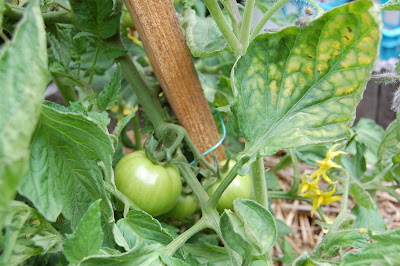
What I've been able to learn about early blight so far suggests it's a root issue; helpful phrases like "sterilize your soil" come up. Great.
The edamame are also struggling, though I think it's something else.

I believe a tiny pest caused these to look like brown-spotted lace, and I know slugs did the rest. I'm just waiting to see whether we'll get a small crop before they become compost.
Not all is gloom and doom, though. The broccoli, kale, potatoes, corn, and squash are thriving; the wax beans are large and lovely, sweet and tender enough to eat fresh off the bush.

And the happiest garden treat of all popped up all on its surprising own:

An honest to goodness morel, one of the most prized edibles out there, growing among the corn. We've been regaled with (Internet) tales from our fellow local mushroom hunters, lucky folks returning from the mountains with sacks full of giant morels. We've considered making the 3-hour drive ourselves, and now looky there!
The garden, she taketh away and she giveth.
Most of my Early Girls are thriving, threatening to grow taller than I.
My Sweet 100s, a couple Sungolds, and even one of my bush Early Girls, on the other hand, are beginning to look like this:
Stefani suggested it might be late blight; I think it's early blight, but the fact is it's blight. My tomatoes are blighted. They've been smote.
What I've been able to learn about early blight so far suggests it's a root issue; helpful phrases like "sterilize your soil" come up. Great.
The edamame are also struggling, though I think it's something else.
I believe a tiny pest caused these to look like brown-spotted lace, and I know slugs did the rest. I'm just waiting to see whether we'll get a small crop before they become compost.
Not all is gloom and doom, though. The broccoli, kale, potatoes, corn, and squash are thriving; the wax beans are large and lovely, sweet and tender enough to eat fresh off the bush.
And the happiest garden treat of all popped up all on its surprising own:
An honest to goodness morel, one of the most prized edibles out there, growing among the corn. We've been regaled with (Internet) tales from our fellow local mushroom hunters, lucky folks returning from the mountains with sacks full of giant morels. We've considered making the 3-hour drive ourselves, and now looky there!
The garden, she taketh away and she giveth.
Saturday, June 13, 2009
All done and off
The cardigan's finished, as of last night, and it's sitting (damply) on a judging table at the fairgrounds.

I was really unhappy with the arms -- both the sleeves and armscyes just stink. Partly my skills (I kept thinking about all the advice about poor finishing ruining a good knitting job) and partly because the sleeves were too big at the top. Too big for a good fit either on me or into the arm holes.
I may get out the sewing machine after the fair and have a go at it. It's already cut; I don't see that I can ruin it any more. But I'll ask a more experienced finisher for advice first.
It sure is pretty, though.
I was really unhappy with the arms -- both the sleeves and armscyes just stink. Partly my skills (I kept thinking about all the advice about poor finishing ruining a good knitting job) and partly because the sleeves were too big at the top. Too big for a good fit either on me or into the arm holes.
I may get out the sewing machine after the fair and have a go at it. It's already cut; I don't see that I can ruin it any more. But I'll ask a more experienced finisher for advice first.
It sure is pretty, though.
"Fireblight"
That's what the nurseryman said he thought it was.

If you're familiar with the disease, you know it's devastating to orchards, and nothing to sniff at at home, either.

So, although I wasn't thrilled about it, I did the necessary cutting. I usually like pruning, figuring that everything can grow back, anyhow, but these were expensive pre-done espaliers, and their graceful forms cheer me. One branch out of eighteen was already broken, and I figure that if things keep on as they have been, I'm going to get some experience grafting.

I kept telling myself that, anyhow. And the (thinned) fruit was mostly on healthy branches, so we may still get a crop this year.
And -- hygiene. I know the rules. I just don't always follow them, figuring again, that everything will be fine. It's not always, though, so a 10% bleach solution before and after every cut.

The material also went straight into the landfill, not even into the municipal green waste. I don't want to spread this around.
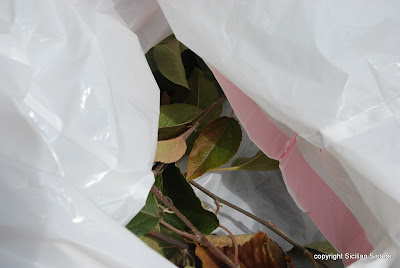
One branch was bad about 80% of the way to the main trunk. We could see the difference in the wood, and cut until the cross section was healthy.

Now I'm wondering if I should have painted all the cuts with bleach. Please don't tell me if it's too late to do anything about it. The nurseryman also promised copper if a hard pruning and deep watering didn't turn them around.
My fingers (and pruning shears) are crossed.
If you're familiar with the disease, you know it's devastating to orchards, and nothing to sniff at at home, either.
So, although I wasn't thrilled about it, I did the necessary cutting. I usually like pruning, figuring that everything can grow back, anyhow, but these were expensive pre-done espaliers, and their graceful forms cheer me. One branch out of eighteen was already broken, and I figure that if things keep on as they have been, I'm going to get some experience grafting.
I kept telling myself that, anyhow. And the (thinned) fruit was mostly on healthy branches, so we may still get a crop this year.
And -- hygiene. I know the rules. I just don't always follow them, figuring again, that everything will be fine. It's not always, though, so a 10% bleach solution before and after every cut.
The material also went straight into the landfill, not even into the municipal green waste. I don't want to spread this around.
One branch was bad about 80% of the way to the main trunk. We could see the difference in the wood, and cut until the cross section was healthy.
Now I'm wondering if I should have painted all the cuts with bleach. Please don't tell me if it's too late to do anything about it. The nurseryman also promised copper if a hard pruning and deep watering didn't turn them around.
My fingers (and pruning shears) are crossed.
Wednesday, June 10, 2009
Keeping Count
One of the themes of this blog, and indeed, of our project together, is keeping track of what we're producing. Sometimes it's very little at a time, but even the small things can pack a wallop. For instance, these "Purple Royalty" rasperries, from the first year planting out front, nearly exploded in my mouth. I must keep paying attention to them, and learning all I can about bramble fruits.

Less exciting, probably because it was from a broken off stem, was the first "Fall Gold" berry. Still, tasty.

One of my favorite poems, "After Apple Picking," by Robert Frost, says in part:
"For I have had too much
Of apple-picking: I am overtired
Of the great harvest I myself desired."
I may never feel this way, without a "real" orchard, but I did another pass along the espaliered trees today and pulled extra fruit off. I did some research that seemed to suggest that thinning not only made bigger apples grow, it tended to even out the production, year to year, for the tree, so there's not a boom and bust cycle. That sounds healthier for both of us, but it still hurts, some, to see the results.

We agreed to keep count of something else -- visitors to the garden! I may skew the count with my hives, but since the seeds came for the Great Sunflower Project today, I dutifully followed through.

I put them right by the zinnias.

Cat asked me to put some in her garden, but I may have to assign her a bigger bed. I couldn't find any more room!

Less exciting, probably because it was from a broken off stem, was the first "Fall Gold" berry. Still, tasty.
One of my favorite poems, "After Apple Picking," by Robert Frost, says in part:
"For I have had too much
Of apple-picking: I am overtired
Of the great harvest I myself desired."
I may never feel this way, without a "real" orchard, but I did another pass along the espaliered trees today and pulled extra fruit off. I did some research that seemed to suggest that thinning not only made bigger apples grow, it tended to even out the production, year to year, for the tree, so there's not a boom and bust cycle. That sounds healthier for both of us, but it still hurts, some, to see the results.
We agreed to keep count of something else -- visitors to the garden! I may skew the count with my hives, but since the seeds came for the Great Sunflower Project today, I dutifully followed through.
I put them right by the zinnias.
Cat asked me to put some in her garden, but I may have to assign her a bigger bed. I couldn't find any more room!
Tuesday, June 9, 2009
Thinning
In order for fruits like apples and some others to reach their full size, it's occasionally necessary to remove one from a cluster. Here you see five apples. The one in the middle is called the "king" apple, and today, the king must die.
After I twist off the middle fruit, you can see how the others have at least a little more room. This is hard for me to do, and I'm not 100% convinced I have it right. On the other hand, these are those under-disease seige espaliered apples, so any crop is a bonus and I want to make it easy on them.
After I twist off the middle fruit, you can see how the others have at least a little more room. This is hard for me to do, and I'm not 100% convinced I have it right. On the other hand, these are those under-disease seige espaliered apples, so any crop is a bonus and I want to make it easy on them.
Subscribe to:
Posts (Atom)